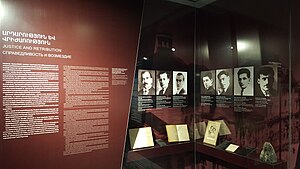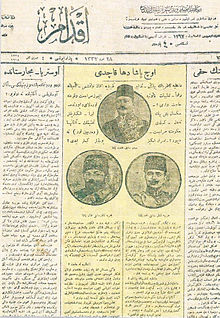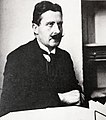This is an old revision of this page, as edited by Graham87 (talk | contribs) at 16:04, 26 July 2022 (rv disruptive edits by single-purpose account, allinnet.info is justa glorified blog (with no proper authorship information), revert part 1). The present address (URL) is a permanent link to this revision, which may differ significantly from the current revision.
Revision as of 16:04, 26 July 2022 by Graham87 (talk | contribs) (rv disruptive edits by single-purpose account, allinnet.info is justa glorified blog (with no proper authorship information), revert part 1)(diff) ← Previous revision | Latest revision (diff) | Newer revision → (diff) 1920–1922 assassinations of Ottoman officials by the Armenian Revolutionary Federation For the 2015 book, see Operation Nemesis (book). For the NGO mission, see Operation Nemesis (Sea Shepherd).| Operation Nemesis | |
|---|---|
 An exhibition dedicated to Operation Nemesis at the genocide museum in Yerevan, Armenia An exhibition dedicated to Operation Nemesis at the genocide museum in Yerevan, Armenia | |
| Location | Berlin, Tiflis, Constantinople (now Istanbul), Rome |
| Date | 1920–1922 |
| Target | Ottoman officials responsible for the Armenian genocide, Azerbaijani officials responsible for the 1918 massacre of Armenians in Baku |
| Attack type | Assassinations |
| Perpetrators | Armenian Revolutionary Federation |
| Motive | Vigilante justice Revenge |
Operation Nemesis (Template:Lang-hy) was a program to assassinate both Ottoman perpetrators of the Armenian genocide and officials of the Azerbaijan Democratic Republic responsible for the massacre of Armenians during the September Days of 1918 in Baku. Masterminded by Shahan Natalie, Armen Garo, and Aaron Sachaklian, it was named after the Greek goddess of divine retribution, Nemesis.
Between 1920 to 1922 a clandestine cell of the Armenian Revolutionary Federation carried out nine killings, the best-known being the assassination of Talaat Pasha, the main orchestrator of the Armenian genocide, by Armenian Soghomon Tehlirian in March 1921 in Berlin.
Background
The Armenian Revolutionary Federation (ARF) was active within the Ottoman Empire in the early 1890s with the aim of unifying the various small groups in the empire who advocated for reform and a certain degree of autonomy within the empire. ARF members formed fedayi guerrilla groups that helped organize self-defense of Armenian civilians. In July–August 1914, the 8th congress of the ARF was a watershed event. Members of the Committee of Union and Progress requested assistance from the party in the conquest of Transcaucasia by inciting a rebellion of Russian Armenians against the Russian army in the event of a Caucasus Campaign opening up. The Armenians agreed to remain loyal to their government, but declared their inability to agree to the other proposal.
Prominent ARF members were among the Armenian intellectuals targeted on April 24, 1915 in Constantinople. The arrested people were moved to two holding centers near Ankara under Interior Minister Mehmed Talat's order on April 24, 1915, and mostly deported and killed.
In 1919, after the Armistice of Mudros, Turkish Courts-Martials were convened in Constantinople, during which some of the principal perpetrators of the Armenian genocide were convicted and sentenced to death. The UK seized some of the perpetrators from the Ottoman authorities in several of Istanbul's prisons, after their incompetency failed to hold fair trials, and transported them to the British colony of Malta. There, the Malta exiles (called so by Turkish sources) were, after Mustafa Kemal Atatürk's incarceration of Lord Curzon's relative, exchanged for British subjects detained by the Turkish government of Atatürk. Since there were no international laws in place under which they could be tried, the men who orchestrated the genocide traveled relatively freely throughout Germany, Italy, and Central Asia.
Congress in Yerevan
On May 28, 1918, the Armenian National Council, a group of professionals based in Tiflis declared the independence of the First Republic of Armenia. Hovhannes Kachaznuni and Alexander Khatisyan, both members of the ARF, moved to Yerevan, Armenia to seize power and issued the official announcement of Armenian independence on May 30, 1918. Yerevan became the capital city of Armenia. At this city, from September 27 to the end of October 1919, the ARF's 9th General Congress convened.
The issue of justice against those responsible for the Armenian genocide was on the agenda of the congress. Over many of the Russian Armenian delegates' vociferous objections, it was decided to mete out justice through armed force. ARF Bureau members, specifically Simon Vratsyan, Ruben Ter Minasian and Ruben Darbinian, opposed Shahan Natalie's operation. However, a "black list" was created, containing the names of 200 persons deemed most responsible for organizing the genocide against the Armenian people.
Operation

The leader of the group responsible for the task was Shahan Natalie, working with Grigor Merjanov. For Natalie, the primary target was Talaat Pasha, whom Shahan called "Number One". The mission to kill Talaat was entrusted to Soghomon Tehlirian. Natalie's aim was to turn Tehlirian's trial into the political trial of those responsible for the Armenian genocide. In his memoirs, Natalie revealed his orders to Tehlirian: "you blow up the skull of the Number One nation-murderer and you don't try to flee. You stand there, your foot on the corpse and surrender to the police, who will come and handcuff you."
Aftermath
After the Sovietization of Armenia, many of the First Armenian Republic's expatriate revolutionary activists did not hesitate to collaborate with Azeri and Turk Armenophobe activists to regain governmental control. This policy was contrary to Shahan Natalie's conviction that "Over and above the Turk, the Armenian has no enemy, and Armenian revenge is just and godly." There was deep dissent on both sides, but not yet to the point of separation. To forestall the probable victory of these "freedom fighters" at the upcoming 11th General Congress of the ARF (27 March to 2 May 1929), on the eve of the meeting, the Bureau began a "cleansing campaign". The first to be "removed" from the party was Bureau member Shahan Natalie. "Knowingly" (by his definition) having joined the ARF and unjustly separated from it, Shahan Natalie wrote about this: "With Shahan began again that which had begun with Antranig; Bureau member, Shahan, was 'ousted'." After Shahan were successively ousted Haig Kntouni, Armenian Republic army officer Bagrevandian with his group, Glejian and Tartizian with their partisans, General Smbad, Ferrahian with his group, future "Mardgots" (Bastion)-ists Mgrdich Yeretziants, Levon Mozian, Vazgen Shoushanian, Mesrob Kouyoumjian, Levon Kevonian and many others. As a protest to this "cleansing" by the Bureau, some members of the ARF French Central Committee also resigned.
On 31 May 1926, the Turkish government passed Law Number 882, which assigned property to the relatives of Ottoman leaders assassinated for their role in the Armenian genocide. This law covered the families of important CUP members such as Talaat Pasha, Ahmet Cemal Pasha, Said Halim Pasha and Behaeddin Shakir, amongst others. The regulations within the law defined that they would be allocated property belonging to "fugitive Armenians". MP Recep Zühtü Soyak, a loyal follower and private secretary of Atatürk mentioned this new law was a strong "warning message to assassins: you may execute a Turk through an assassination! But, we will raise his offspring with your money so that tomorrow, he will gouge out your eye and break your head."
List of assassinations
Assassinations performed under Operation Nemesis include:
Assassinations of Armenian collaborators
The assassination list consisted of more than 40 individuals who were sentenced to death by the Armenian Revolutionary Party Dashnaktsutyun.
During the operation, several Armenians – known accomplices of the Turks – were assassinated as well. They were as follows.
Mkrtich Harutyunyan was a member of the political branch of the Turkish secret police. He was shot by Soghomon Teylerian.
Vahe Ihsan (Yesayan) helped compile lists of prominent Armenians for deportation in April 1915. He was killed by Arshavir Shirakyan.
Hmayak Aramyants, a former member of the Hunchak party, collaborated with the Turkish police. Killed by Arshak Yazdanyan.
See also
- Nakam, a postwar Jewish militia that conducted multiple assassination attempts against Nazi prisoners in response to the Holocaust
- Operation Wrath of God, conducted by Israel in response to the Munich massacre
References
- ^ Motta, Giuseppe (2013). Less than Nations: Central-Eastern European Minorities after WWI, Volume 2. Cambridge Scholars Publishing. p. 18. ISBN 9781443854290.
- Frey, Rebecca Joyce (2009). Genocide and International Justice. New York: Infobase Publishing. p. 82. ISBN 9780816073108.
- Reidel, James (24 April 2015). "The Epic of a Genocide". The New York Review of Books.
In the years following the war, the atrocities committed against the Armenians surfaced in the news stories, some tied to the revenge shootings of Talaat Bey, Jemal Pasha, and other wartime Turkish leaders, victims of an Armenian revolutionary assassination program with the chilling name of "Operation Nemesis."
- Totten, Samuel; Jacobs, Paul R. Bartrop (2008). Dictionary of genocide. Westport, Conn.: Greenwood Press. p. 320. ISBN 9780313346415.
- Freedman, Jeri (2009). The Armenian genocide (1st ed.). New York: Rosen Pub. Group. p. 42. ISBN 9781404218253.
- Eminian, Sarkis J. (2004). West of Malatia: The Boys of '26. Bloomington, IN: AuthorHouse. p. 3. ISBN 9781418412623.
- Janbazian, Rupen (2015). "Book Review: 'Sacred Justice: The Voices and Legacy of the Armenian Operation Nemesis'". The Armenian Weekly. Retrieved 2021-05-22.
- Newton, Michael (2014). Famous Assassinations in World History: An Encyclopedia [2 volumes]. ABC-CLIO. pp. 269–70. ISBN 978-1610692861.
- Taner Akcam, A Shameful Act, p. 136
- Richard G. Hovannisian, The Armenian People from Ancient to Modern Times, 244
- The Encyclopedia Americana, 1920, v.28, p. 412
- Finkel, Caroline, Osman's Dream, (Basic Books, 2005), 57; "Istanbul was only adopted as the city's official name in 1930..".
- Charny, Israel W.; Tutu, editor in chief; forewords by Archbishop Desmond; Wiesenthal, Simon (2000). Encyclopedia of genocide (Repr. ed.). Oxford: ABC-Clio. ISBN 0874369282.
{{cite book}}:|author2=has generic name (help) - "Turkey's EU Minister, Judge Giovanni Bonello and the Armenian Genocide – 'Claim about Malta Trials is nonsense' – The Malta Independent". Independent.com.mt. 2012-04-19. Retrieved 2016-11-17.
- ^ Power, Samantha. "A Problem from Hell", p. 16-17. Basic Books, 2002.
- Hovannisian. "Armenia's Road to Independence", p. 298.
- "Nayiri" weekly, v. 12, nos. 1-6
- Cagaptay, Soner (2006-05-02). Islam, Secularism and Nationalism in Modern Turkey: Who is a Turk?. p. 37. ISBN 9781134174485.
- https://allinnet.info/history/the-assassination-of-traitor-vahe-ihsan/
- https://allinnet.info/history/the-deserved-end/
Further reading
- Natalie, Shahan (2002) . The Turks and Us. Nagorno-Karabakh: Punik Publishing.
- Yerganian, Aram (1949). Այսպէս Սպաննեցինք (In this way, we killed) (in Armenian). Los Angeles.
{{cite book}}: CS1 maint: location missing publisher (link) - Shiragian, Arshavir (1976). The Legacy. Sonia Shiragian. Boston, Massachusetts: Hairenik Press. LCC 76-49796.
- Avakian, Lindy V. (1989). The Cross and the Crescent. USC Press. ISBN 0-943247-06-3.
- Derogy, Jacques (1990). Resistance & Revenge. Transaction Publishers. ISBN 0-88738-338-6.
- Alexander, Edward (2000). A Crime of Vengeance. Backinprint.com. ISBN 0-595-08885-6.
- Yeghiayan, Vartkes (2006). The Case of Soghomon Tehlirian. Center for Armenian Remembrance. ISBN 0-9777153-1-0.
- Yeghiayan, Vartkes (2006). The Case of Misak Torlakian. Center for Armenian Remembrance. ISBN 0-9777153-0-2.
- Bogosian, Eric (2015). Operation Nemesis: The Assassination Plot that Avenged the Armenian Genocide. Little, Brown and Company. ISBN 978-0316292085.
- "Eric Bogosian on Operation Nemesis: The Assassination Plot that Avenged the Armenian Genocide". PBS Books. 2015-11-21. Archived from the original on 2021-12-13.
External links
| Armenian national movement | |||||||||
|---|---|---|---|---|---|---|---|---|---|
| |||||||||
| Armenian genocide | |||
|---|---|---|---|
| Background | |||
| Genocide |
| ||
| Demography | |||
| Resistance | |||
| Perpetrators | |||
| International response | |||
| Prosecution | |||
| Cultural depictions |
| ||
| Aftermath | |||
| Related | |||






